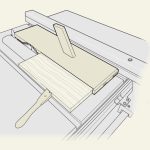We may receive a commission when you use our affiliate links. However, this does not impact our recommendations.
 After Dave excavated the bowl and trimmed the end grain, he sanded the inner bowl and was ready to add one more element – a stabilizing leg that would level the bowl. As I mentioned last week, each of the crotch bowl arms had a different thickness, and once laid flat on a surface, the bowl became off-kilter.
After Dave excavated the bowl and trimmed the end grain, he sanded the inner bowl and was ready to add one more element – a stabilizing leg that would level the bowl. As I mentioned last week, each of the crotch bowl arms had a different thickness, and once laid flat on a surface, the bowl became off-kilter.

To level the bowl, we could have shaved off the thicker arms of the “Y” and reduced them to match the thickness of the narrowest arm or incorporated a detail that would pry it up just enough to look and feel level.
Dave and I thought the latter approach made more sense, and since Dave is also a turner, he decided to turn a small balancing leg and glue it into a counterbore hole.li
Here are some sketches I made to demonstrate the different design options for the leg to Dave.

The angled hole and the leg.


We splayed the leg to add some movement to the bowl.



Dave’s bowl resting on Mike’s formidable live edge table.

After a few layers of finish applied at home after the class ended.


I hope Dave’s branch bowl will inspire many to explore the artistic and practical potential found in branches and crotches. As Dave has demonstrated, working with natural shapes has some notable advantages, as the organic beauty of the original piece provides a supportive road map toward a meaningful artistic resolution.
Here are some supplies and tools we find essential in our everyday work around the shop. We may receive a commission from sales referred by our links; however, we have carefully selected these products for their usefulness and quality.








